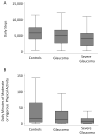Real-world assessment of physical activity in glaucoma using an accelerometer
- PMID: 22386950
- PMCID: PMC3367112
- DOI: 10.1016/j.ophtha.2012.01.013
Real-world assessment of physical activity in glaucoma using an accelerometer
Abstract
Objective: To determine the association between glaucomatous visual field (VF) loss and the amount of physical activity and walking in normal life.
Design: Prospective, observational study.
Participants: Glaucoma suspects without significant VF or visual acuity loss (controls) and glaucoma subjects with bilateral VF loss between 60 and 80 years of age.
Methods: Participants wore an accelerometer over 7 days of normal activity.
Main outcome measures: Daily minutes of moderate or vigorous physical activity (MVPA) was the primary measure. Steps per day was a secondary measure.
Results: Fifty-eight controls and 83 glaucoma subjects provided sufficient study days for analysis. Control and glaucoma subjects were similar in age, race, gender, employment status, cognitive ability, and comorbid illness (P>0.1 for all). Better-eye VF mean deviation (MD) averaged 0.0 decibels (dB) in controls and -11.1 dB in glaucoma subjects. The median control subject engaged in 16.1 minutes of MVPA daily and walked 5891 steps/day, as compared with 12.9 minutes of MVPA daily (P = 0.25) and 5004 steps/day (P = 0.05) for the median glaucoma subject. In multivariate models, glaucoma was associated with 21% less MVPA (95% confidence interval [CI], -53% to 32%; P = 0.37) and 12% fewer steps per day (95% CI, -22% to 9%; P = 0.21) than controls, although differences were not statistically significant. There was a significant dose response relating VF loss to decreased activity, with each 5 dB decrement in the better-eye VF associated with 17% less MVPA (95% CI, -30% to -2%; P = 0.03) and 10% fewer steps per day (95% CI, -16% to -5%; P = 0.001). Glaucoma subjects in the most severe tertile of VF damage (better-eye VF MD worse than -13.5 dB) engaged in 66% less MVPA than controls (95% CI, -82% to -37%; P = 0.001) and took 31% fewer steps per day (95% CI, -44% to -15%; P = 0.001). Other significant predictors of decreased physical activity included older age, comorbid illness, depressive symptoms, and higher body mass index.
Conclusions: Overall, no significant difference in physical activity was found between individuals with and without glaucoma, although substantial reductions in physical activity and walking were noted with greater levels of VF loss. Further study is needed to characterize better the relationship between glaucoma and physical activity.
Financial disclosure(s): The author(s) have no proprietary or commercial interest in any materials discussed in this article.
Copyright © 2012 American Academy of Ophthalmology. Published by Elsevier Inc. All rights reserved.
Conflict of interest statement
Conflict of Interest: No conflict of interest for any author.
Figures



Similar articles
-
Patterns of Daily Physical Activity across the Spectrum of Visual Field Damage in Glaucoma Patients.Ophthalmology. 2021 Jan;128(1):70-77. doi: 10.1016/j.ophtha.2020.06.053. Epub 2020 Jun 29. Ophthalmology. 2021. PMID: 32615202 Free PMC article.
-
Visual field loss and accelerometer-measured physical activity in the United States.Ophthalmology. 2012 Dec;119(12):2486-92. doi: 10.1016/j.ophtha.2012.06.034. Epub 2012 Aug 11. Ophthalmology. 2012. PMID: 22892152
-
Greater Physical Activity Is Associated with Slower Visual Field Loss in Glaucoma.Ophthalmology. 2019 Jul;126(7):958-964. doi: 10.1016/j.ophtha.2018.10.012. Epub 2018 Oct 10. Ophthalmology. 2019. PMID: 30315900 Free PMC article.
-
Glaucomatous visual field loss associated with less travel from home.Optom Vis Sci. 2014 Feb;91(2):187-93. doi: 10.1097/OPX.0000000000000139. Optom Vis Sci. 2014. PMID: 24374635 Free PMC article.
-
Fear of falling and visual field loss from glaucoma.Ophthalmology. 2012 Jul;119(7):1352-8. doi: 10.1016/j.ophtha.2012.01.037. Epub 2012 Apr 4. Ophthalmology. 2012. PMID: 22480738 Free PMC article.
Cited by
-
Patterns of Daily Physical Activity across the Spectrum of Visual Field Damage in Glaucoma Patients.Ophthalmology. 2021 Jan;128(1):70-77. doi: 10.1016/j.ophtha.2020.06.053. Epub 2020 Jun 29. Ophthalmology. 2021. PMID: 32615202 Free PMC article.
-
Importance and Severity Dependence of Physical Activity by GPS-Tracked Location in Glaucoma Patients.Am J Ophthalmol. 2021 Oct;230:276-284. doi: 10.1016/j.ajo.2021.04.032. Epub 2021 May 13. Am J Ophthalmol. 2021. PMID: 33992612 Free PMC article.
-
Gaze Scanning on Mid-Block Sidewalks by Pedestrians With Homonymous Hemianopia With or Without Spatial Neglect.Invest Ophthalmol Vis Sci. 2024 Jul 1;65(8):46. doi: 10.1167/iovs.65.8.46. Invest Ophthalmol Vis Sci. 2024. PMID: 39078731 Free PMC article.
-
Physical Activity Is Associated with Improved Visuomotor Processing in Older Adults with Moderate and Advanced Glaucomatous Visual Field Defect: A Cross-Sectional Study.Int J Environ Res Public Health. 2022 Feb 3;19(3):1760. doi: 10.3390/ijerph19031760. Int J Environ Res Public Health. 2022. PMID: 35162783 Free PMC article.
-
Physical Activity, Cardiorespiratory Fitness, and Incident Glaucoma.Med Sci Sports Exerc. 2018 Nov;50(11):2253-2258. doi: 10.1249/MSS.0000000000001692. Med Sci Sports Exerc. 2018. PMID: 29985830 Free PMC article.
References
-
- Aspinall PA, Johnson ZK, Azuara-Blanco A, et al. Evaluation of quality of life and priorities of patients with glaucoma. Invest Ophthalmol Vis Sci. 2008;49:1907–15. - PubMed
-
- Popescu ML, Boisjoly H, Schmaltz H, et al. Age-related eye disease and mobility limitations in older adults. Invest Ophthalmol Vis Sci. 2011;52:7168–74. - PubMed
Publication types
MeSH terms
Grants and funding
LinkOut - more resources
Full Text Sources
Medical
Miscellaneous

